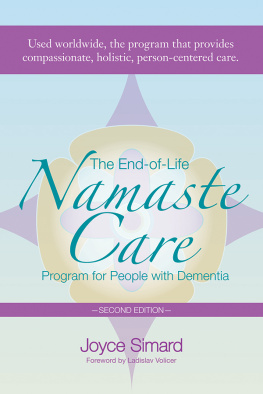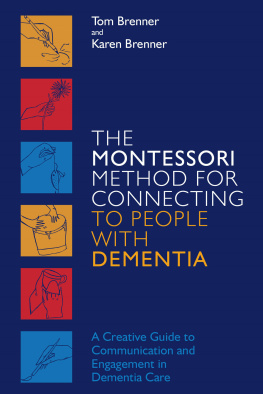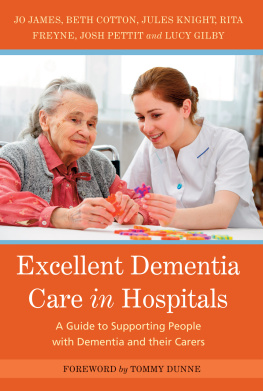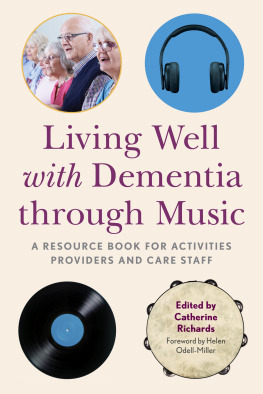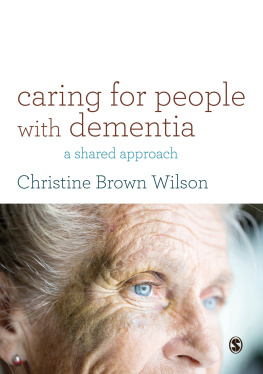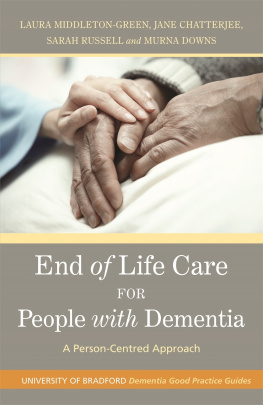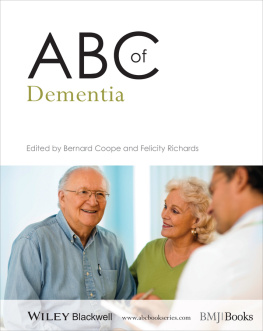The End-of-Life
Namaste Care TM
Program for People with Dementia
SECOND EDITION
Joyce Simard, M.S.W.


Health Professions Press, Inc.
Post Office Box 10624
Baltimore, Maryland 21285-0624
www.healthpropress.com
Copyright 2013 by Health Professions Press, Inc.
All rights reserved.
Cover and logo designs by Mindy Dunn.

Namaste Care and the Namaste Care logo are trademarks of
Health Professions Press, Inc.
The information provided in this book is in no way meant to substitute for a medical practitioners advice or expert opinion. Readers should consult a medical practitioner if they are interested in more information. This book is sold without warranties of any kind, express or implied, and the publisher and author disclaim any liability, loss, or damage caused by the contents of this book.
All of the case studies described in this book are based on the authors actual experiences, but the names and identifying details have been changed to protect privacy. Exceptions include Arden Courts of HCR ManorCare (throughout); EPOCH Senior Living (throughout); Seasons Hospice (); Vermont Veterans Home (Chapters 3 and 4); and Matthew and Celia Wilk (throughout), whose stories recounted in this book are real and whose permission for this use is gratefully acknowledged.
e-Book ISBN-13 978-1-938870-20-0 ISBN-10 1-938870-20-4
Printed edition Library of Congress Cataloging-in-Publication Data
Simard, Joyce.
The end-of-life Namaste Care program for people with dementia / by Joyce Simard. 2nd ed.
p. ; cm.
Includes bibliographical references and index.
ISBN 978-1-938870-02-6 (pbk.)
I. Namaste Care (Program) II. Title.
[DNLM: 1. Alzheimer Diseasenursing. 2. Dementianursing. 3. Holistic Health. 4. Terminal Caremethods. WY 152]
RC521
616.8'31029dc23
2013002144
British Library Cataloguing in Publication data are available from the British Library.
Contents
Appendixes
About the Author
Joyce Simard, M.S.W., is a private geriatric consultant to skilled nursing centers, assisted living communities, and hospice organizations worldwide. She is also involved in research projects investigating the effects of Namaste Care in Australia and the United Kingdom. She earned her bachelor of arts in sociology and social work from Ithaca College in New York and her masters of social work from the University of Minnesota. She also serves as Adjunct Associate Professor at the School of Nursing and Midwifery, University of Western Sydney, Australia.
In addition to the Namaste Care program, Simard has developed other programs for people with memory loss. The Memory Enhancement Program (MEP) is for people experiencing memory loss above and beyond what is normal for their age and education. Residents in independent living and assisted living communities as well as those who participate in adult day programs benefit from this unique program. The Club is a program for residents in nursing facilities and assisted living who have moderate memory loss. Its implementation has resulted in a decrease in anti-psychotic medications as well as a decline in resident falls and improved staff and resident satisfaction.
Simard is the author of a childrens book about aging and dementia, The Magic Tape Recorder (2007), which was published in several languages and is currently out of print.
Simard is an internationally recognized speaker who has presented both to families of people with dementia and to health care professionals in the United States, Europe, Australia, and parts of Asia. As a keynote or featured speaker at professional conferences, she is known for bringing humor and a light touch to serious subjects, teaching through stories of real experiences from her 35 years in health care. She also provides in-service training on a variety of subjects, including hospice, bereavement, comfort care, and activity programs for people with all stages of dementia.
More information can be found at
Foreword
Publication of the first edition of The End-of-Life Namaste Care Program for People with Dementia encouraged many health care providers to reassess how to care for individuals with advanced dementia. Although Namaste Care was originally intended for implementation in long-term care facilities, the program has since been adapted in other settings where individuals with advanced dementia live, specifically assisted living communities and hospices. This second edition is a result of the expansion of Namaste Care and the popularity of the first edition.
Since the publication of the first edition, Namaste Care programs have been successfully implemented throughout the United States as well as in Australia, England, Scotland, and Greece. One large assisted living organization in the U.S., Arden Courts, chose to incorporate Namaste Care into all of its facilities. A hospice organization, Seasons Hospice, is using the Namaste Care approach in all of its facilities as well, under its own customized name (Touch for All Seasons). The success of Namaste Care was also reflected in the selection of Joyce Simard, M.S.W., as one of Provider magazines 20 to Watch in 2013 for her compassion and commitment to providing quality of life at the end of life for individuals with advanced dementia.
Namaste Care is an enlightened program that strives to maintain the highest quality of life possible for individuals with severe and terminal dementia. This care involves the creation of a special room that provides a quiet, peaceful environment for residents in the last stage of the disease. Meaningful activities are individualized for each resident and a continuous presence of staff members provides both physical and sensory stimulation. Namaste Care does not require additional staff, just some rethinking of staff assignments, and can be implemented with minimal programming cost. This high-touch care can be taught to all staff as well as to family members. The family members in particular appreciate the attention given to their loved ones.
I am sure that publication of this second edition of The End-of-Life Namaste Care Program for People with Dementia will encourage many more long-term care facilities, assisted living communities, and hospices to pay greater attention to individuals with advanced dementia as well as other terminal diseases and conditions. The book will hopefully serve as an important road map in this effort because it describes in detail how the program can be implemented, how the Namaste Care team is established, how an appropriate Namaste Care environment is created, and what the days activities could look like. In addition, the book discusses decision making at the end of life and what is meant by comfort care. An understanding of death and dying and the need for care after death are also provided. Finally, the appendices include useful resources for establishing a Namaste Care program.
Namaste Care provides residents and their families with quality care that addresses not only physical but also emotional and spiritual needs. It reminds us that individuals with advanced dementia should not be isolated in their rooms, but instead need to live their last days in a pleasant environment receiving loving care from all staff and families.
Next page
